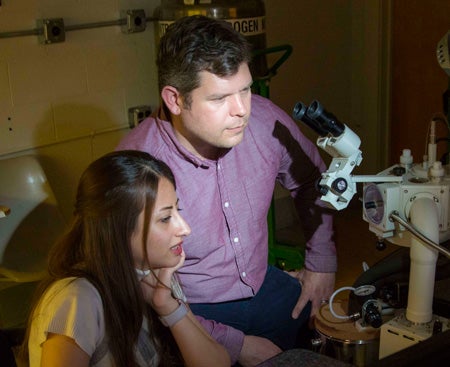
Don’t tell Geoff Bothun not to sweat the small stuff, because he knows better. In Professor Bothun’s world of engineering, focusing on the little things may be the key to improving our health, protecting the environment, keeping us safe and living longer.
The URI professor of chemical engineering studies how to use nanotechnology to manipulate cells or molecules, enabling engineers to design materials, products and processes for biomedical and environmental applications like never before.
Imagine tiny particles 100 times thinner than a human hair that have properties that can improve almost any product. They’re infused in 1,600 goods—they make tennis balls last longer and bandages heal wounds faster, they clean the exhaust in diesel engines and increase the speed and memory of computers. In the medical field, nanoparticles can be injected into the body, pass through the circulatory system, hide from the immune system, and deliver a cargo of medicine to targeted cells.
Bothun has a great interest in workforce development for the nanotechnology industry, which is expected to grow to $3 trillion by 2020.
“It’s the next industrial revolution,” said Professor Bothun. “Because nanoparticles are so small and invisible to the naked eye, it’s easy to incorporate them into a wide range of materials.” Most are suspended in fluids like car lubricants and skin lotion, while many others are incorporated into textiles and electronics.
Bothun has set his sights on using nanotechnologies to improve magnetic resonance imaging (MRI), a medical diagnostics tool that uses magnetic fields and radio waves to create images of anatomy and physiological processes. He believes that the use of magnetic nanoparticles could improve the imagery by increasing the contrast and resolution between healthy and diseased cells, helping doctors detect diseases at earlier stages. He is especially focusing on using nanotechnology to aid in the early detection of glioblastoma, an aggressive brain cancer that is difficult to treat and offers little hope of a cure.

But that’s not all. Bothun also directs the Rhode Island Consortium for Nanoscience and Nanotechnology, which brings together nanotechnology researchers from URI, Brown University and elsewhere for research collaborations. The consortium has laboratory equipment and space in Crawford Hall and Morrill Hall where local and national companies often can be found conducting analyses of their products.
In addition, Bothun has a great interest in workforce development for the nanotechnology industry, which is expected to grow to $3 trillion by 2020.
“Nanotechnology represents the next technological revolution, so in the next 5 to 10 years there are going to be lots of jobs in this area,” he said. “And that means we need graduates trained in how to use the instruments to characterize products containing nanotechnology.”
So where will the nanotechnology field go next?
“I expect that within 5 or 10 years we’ll have nano-medicines that are safe, specific, personalized and smart,” Bothun said. “We’ll soon get to the point where we can design systems tailor-made for specific diseases and specific individuals.”
In the meantime, he is looking forward to a large state-of-the-art nanotechnology and imaging laboratory in the new College of Engineering building, which will break ground next year.
“I’m really excited about the possibilities.”
